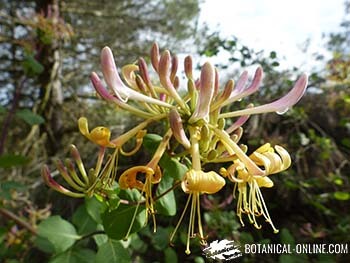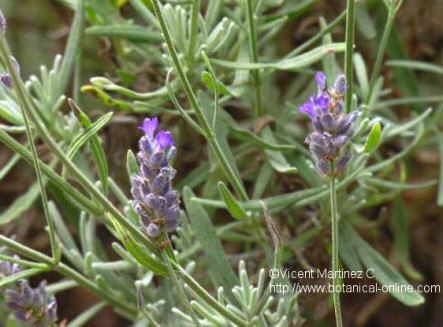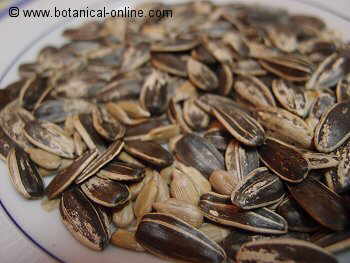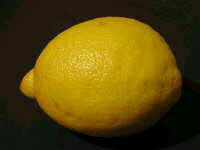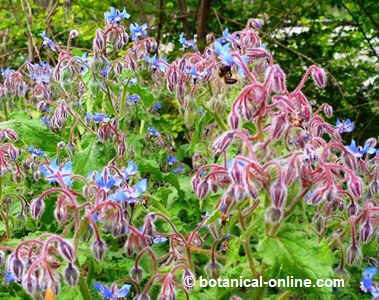Contents
- 1 Characteristics of lianas
- 1.1 What is a liana?
- 1.2 Why did some plants become lianas?
- 1.3 Types of lianas
- 1.4 What are lianas with twining stems?
- 1.5 Characteristics of climbing plants with aerial roots
- 1.6 What are tendril lianas?
- 1.7 Classification of lianas according to their life cycle
- 1.8 What are annual lianas?
- 1.9 What are perennial lianas?
Characteristics of lianas
What is a liana?
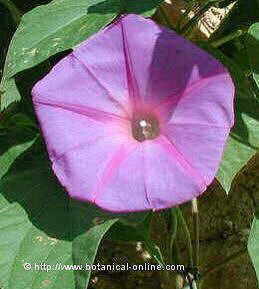
Lianas, climbing plants or vines are those that use a series of resources to climb and rise on other plants or on some support that can support them, such as a tree or bush, a fence, a wall, a rock, a pole, etc.
Why did some plants become lianas?
Lianas are the result of adaptations produced over many years. In this way, they manage to leave the ground and rise in the direction of sunlight to achieve more efficient photosynthesis.
Many plants, such as trees or shrubs, manage to raise their plant mass by developing hardened trunks that support the weight of the rest of the plant above the ground.
Another way to achieve the same thing without developing trunks is to raise your plant mass by twisting around a support to be able to climb, as they do what is known as vines or climbing plants.
Thanks to this resource, climbing plants are able to separate themselves from the ground, where it is easier for them to suffer attacks, such as pests, herbivore bites, insect attacks, etc. It should also be noted that a plant with flimsy stems crawling on the ground is more prone to rot as a result of humidity.
The fact that lianas can twist or cling to other plants makes them in many cases dangerous plants for other species, which they “strangle” depriving them of light to the point that they can kill them, such is the case of many ivies that dry up the pines or other trees they use to climb.
Many lianas also have very efficient resources to reproduce, which is why, on some occasions, they become real invasive weeds, much feared by farmers or gardeners who are forced to prevent or limit their expansion. Among these types of herbs we have,for example,blue morning glory (Ipomoea acuminata).
Types of lianas
Classification of climbing plants according to the way of climbing
According to the way in which climbing plants manage to climb, they are classified into the following types:
- Climbing plants with twining stems
- Climbing plants with aerial roots.

Honeysuckle, a liana, the flowers of which can be used to treat respiratory diseases in infusion form Climbing plants with tendrils
What are lianas with twining stems?
They are those that wind around the supports, managing to rise with the help of their relatively narrow and flexible stems, preferably herbaceous in nature, although some of them develop woody stems, such as wisteria.
Among these we have, for example, honeysuckles (Lonicera spp.), morning glories (Ipomoea spp), nasturtiums (Tropaeolum spp), wisteria (Wisteria spp.), Solanum spp., wax plant (Hoya carnosa), crossvine (Bignonia capreolata), Podranea ricasoliana, flamevine (Pyrostegia venusta), Pandorea ssp, Podranea spp. or binweeds (Convolvulus spp.).
Characteristics of climbing plants with aerial roots
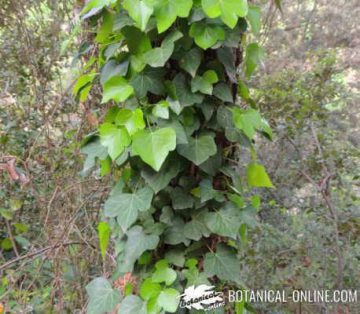
They are those that develop small roots with which they manage to cling to some support, even in places with less grip such as walls.
Among this group, stand out ivies (Hedera spp.) such as common ivy (Hedera helix), Persian ivy (Hedera colchica) or Canary ivy (Hedera canariensis).
The Campsis genus consists of two species that also develop aerial roots. One of them, called Chinese trumpet vine (Campsis grandiflora = Bignonia grandiflora), is capable of holding the plant with them in any support. The other, called cow itch vine (Campsis radicans = Bignonia radicans), needs to be held in other ways because its roots are not strong enough to support the plant.
What are tendril lianas?
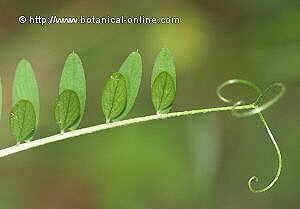
They are those that manage to climb using tendrils. Tendrils are stems, leaves or petioles of a leaf specially adapted to roll on some handle and to be able to support the plant.
Within this group we have many plants belonging to Papilionaceae family, in which this type of plant structure is common, as occurs with food plants such as peas, or in other garden plants such as peavines, Lathyrus (L. odoratus, L. aphaca, L. latifolius, etc.), passion flowers or Clematis spp.
Classification of lianas according to their life cycle
We can group climbing plants into two types according to their duration over time:
- Annual lianas
- Perennial lianas
What are annual lianas?
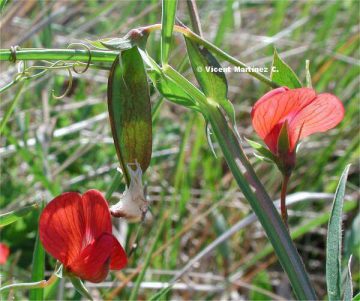
They are those climbing plants that, generally, when grown, last a single season, although there are some annuals that can live more than a year when grown in hot climates.
Among the main annual climbers we can mention the following:
- Lathyrus: There are approximately 150 species of Lathyrus. Most of them come from the temperate regions of the northern hemisphere, although there are some species native to the Andes. It is a genus closely related to pea (Pisum sativum). In fact, some species are edible plants. They are used in gardening because many of them are climbing plants using tendrils and because of their showy mauve, blue, white or pale yellow flowers. They must be grown in the sun in fertile, well-drained soil. Supports will be provided for them to climb. Among all of them, sweet pea (Lathyrus odoratus) is distinctive which was one of the main species that Gregor Mendel used in his studies of his genetic work to elaborate the famous Mendel’s Laws. It is not surprising that today we have so many varieties of this species in gardening (Lathyrus odoratus “Carnival”, Lathyrus odoratus “Katherine”, Lathyrus odoratus “Lucy”, Lathyrus odoratus “Hampton Court”, etc). Other well-known species are: Lathyrus nervosus or the perennial peavine (Lathyrus latifolius).
- Nasturtiums: There are approximately 87 species of the genus Tropaeolum, coming from the warm regions of South America and Mexico. Some are annual; others are twining climbing perennials. They stand out for the beauty of their flowers. They should be grown in the sun or in semi-shade and need a moist and well-drained soil. Among all of them, are distinctive garden nasturtium (Tropaeolum majus), canarybird flower (Tropaeolum peregrinum), flame flower (Tropaeolum speciosum), mashua (Tropaeolum tuberosum) or Chilean nasturtium (Tropaeolum tricolor).
- Thunbergias: From Africa and Asia, there are approximately 100 species of the genus Thunbergia. Among these there are many that are twining climbers. Most form individual trumpet-shaped flowers. They need a drained and fertile soil and a sunny exposure, except in the middle of summer that they prefer some shade. Among all of them, the following stand out: black-eyed susana vine (Thunbergia alata), Bengal clockvine (Thunbergia grandiflora), scarlet thunbergia (Thunbergia coccinea), orange clockvine (Thunbergia gregorii), dwarf thunbergia (Thunbergia natalensis), Thunbergia togoensis, etc.
- Morning glories: They exist approximately 300 species of the genus Ipomoea. They come from tropical and warm temperate zones. Many of them are twining climbers, with very short-lived infundibuliform flowers, although they are continually producing new flowers. They prefer warm, coastal climates and a sunny exposure. Many of them are considered invasive plants: common morning glory (Ipomoea purpurea), jalap (Ipomoea purga), cypress vine (Ipomoea quamoclit), blue morning glory (Ipomoea indica), fire vine (Ipomoea lobata), moonflower (Ipomoea alba), sweet potato (Ipomoea batatas).
- Bindweeds: There are approximately 250 species of the Convolvulus genus. Many of them are climbing plants with flimsy twining stems and flowers similar to morning glories, from which they differ because Convolvulaceae flowers are more durable, since they do not usually wither or close at noon or in the afternoon. They grow spontaneously in many temperate areas around the world. They are very resistant plants that need a culture in full sun. Some of them are invasive weeds. The most prominent is dwarf morning-glory (Convolvulus tricolor).
What are perennial lianas?
They are those that last more than a season, although there are many climbing plants that being perennial in their place of origin are grown as annuals.
Among the main perennial climbers we can mention the following:
- Passion flowers: There are approximately 400 species in this group. They come mainly from the tropical zone of South America. They should be grown in warm areas, on rich, well-drained soils. It is necessary to provide them some support so that they can climb through their tendrils. Among them all stand out: blue passionflower (Passiflora caerulea), passion fruit (Passiflora edulis), giant granadilla (Passiflora quadrangularis), red passion flower (Passiflora coccinea), red passion flower (Passiflora racemosa), perfumed passionflower (Passiflora vitifolia), orange-petaled passion flower (Passiflora aurantia), red banana passionfruit (Passiflora antioquiensis), water lemon (Passiflora laurifolia), Passiflora manicata, etc.
- Jasmines: There are approximately 200 jasmine species from Asia and Africa. Some are shrubs; other climbing plants. The latter are usually planted for their white, yellow or red-pink flowers that are usually aromatic. They need to cultivate in the sun in fertile, well-drained soil. Among all of them, we will highlight the following: Common Jasmine (Jasminum officinale), pink jasmine (Jasminum polyanthum), Italian jasmine (Jasminum humile), lemon-scented jasmine (Jasminum azoricum), Jasminum rex, Arabian Jasmine (Jasminum sambac).
![]() More information on plant characteristics and types
More information on plant characteristics and types

